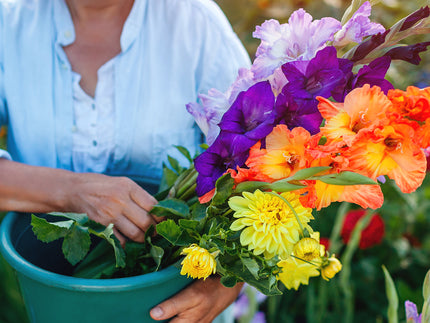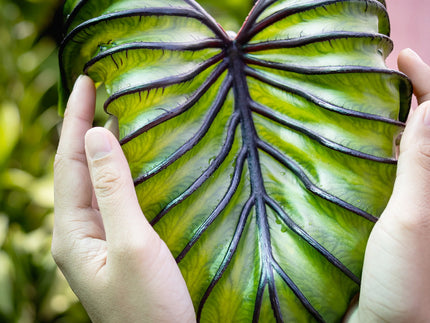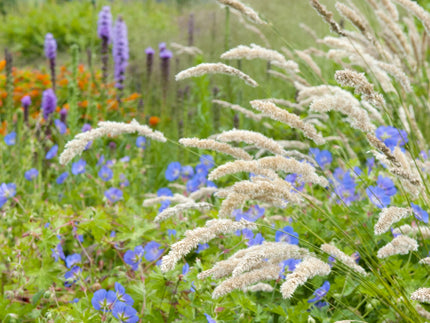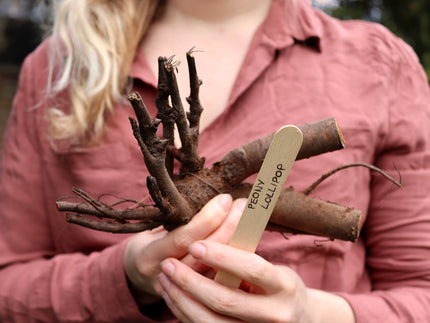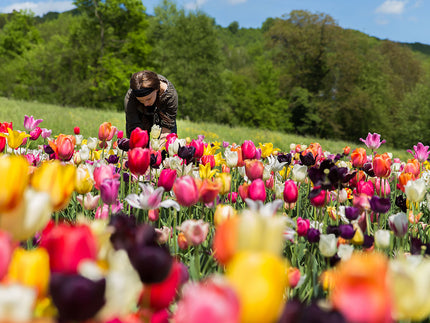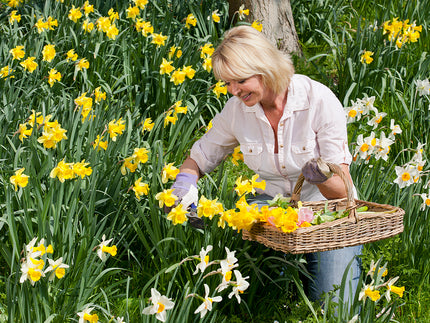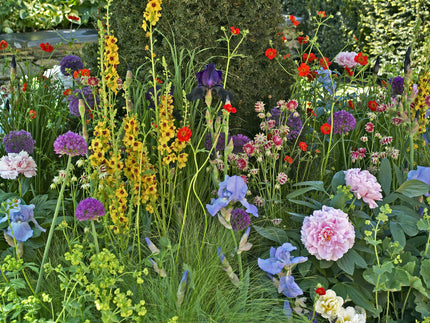
Papaver — Tops of the poppies!
Poppies are, quite simply, brilliant! They are glamorous and flamboyant, yet graceful. They are bright and astonishingly diverse, yet simple to grow. It should therefore no surprise to discover that they are among the most popular plants available today. Whether they are annual or perennial in nature, they are firm favourites with experienced gardeners and green-fingered beginners alike!
The poppy genus – Papaver – contains around 50 species, and they come in a spectrum of colours. Annual poppies, such as the common or Flanders poppy (Papaver rhoeas) and the opium poppy (P. somniferum) are certainly beautiful, and worthy of a place in any summer garden.
However, the real joy of poppies for increasing numbers of gardeners are the Oriental Hybrid Poppies — perennial types that come back year after year. They are, in the main, forms of P. orientale, however botanists over the years have disagreed many times as to the actual species involved, with P. bracteatum and P. pseudo-orientale also getting in on the act. Fortunately, this botanical confusion is of little concern to the gardener, who really just wants some fabulous plants to grow and enjoy – and we have been able to secure a number of the very best Oriental Poppy cultivars for its customers.
They are incredibly hardy, and they are full of character. They provide a cheerful display of huge, satiny flowers, in a wide range of colours, in late spring and early summer – just as the spring bulbs have finished, and before the summer flowers have started.
Oriental Poppy blooms are good for cutting for indoor decoration, too, and are commonly sold in the summer flower markets of The Netherlands, Germany and elsewhere. They are best cut just before the buds open to reveal the petals. The cut ends of the stems should be sealed by burning them over a candle flame, or placing them for a short while in boiling water; this prevents them from wilting.
How to grow Oriental Poppies
Oriental poppies are great border and flowerbed plants, and they can make good container plants – however they are not commonly seen in containers (because they die back to just a small clump of green leaves over winter, only to re-start into growth again in spring). Choose a deep container, as poppies have long tap roots, and fill it with a mixture of John Innes No.3 and a soil-less compost. If the roots languish in damp soil they are likely to rot, so don’t place a saucer under the pot. Instead, stand it on pot feet.
For the same reason, don’t plant these poppies in boggy ground; otherwise, any type of soil will do. A position in full sun is best. Get them off to a good start by incorporating plenty of organic material into the soil, such as well-rotted home-made compost, or bagged farmyard or horse manure.
For experienced gardeners, Oriental Poppy seed is available, and this may be sown in spring or autumn. Note, however, that most are hybrids, and they will not come true from seed, so it is far easier, and more accurate, to buy young, named plants. These can be planted in the ground all year round, providing conditions are suitable (that is, when the soil is not frozen, waterlogged or baked dry in a drought); the best times for planting are in spring or autumn.
The leaves appear early in the year, forming neat rosettes. In late spring, tall stems develop fat, hairy buds, and when these open they offer out their gloriously crumpled, papery petals. Bees and pollinating insects find it easy to access the centres of the blooms, and lap up the nectar that’s available.
Removing the dead flowers, and therefore stopping the production of seedheads, will prolong the flowering period. Snip out the entire stem. After the last flower fades, cut the all stems back hard to within 7cm / 3" of the ground – this may encourage a second flush of flowers in late summer or autumn.
It is a good idea to apply a general fertilizer during spring, but only do this once a year. Follow this with a mulch of bark chippings to retain soil moisture over the hottest months. Oriental poppies are very long-lived, and they have deep roots so, once planted, they don’t like to be moved. The clumps will become larger each year, but they will never become invasive.
After several years, the centre of a mature plant can become less productive, however it’s easy to revitalise large, old plants. During spring, prise them from the ground with a fork, and divide them into several smaller pieces, throwing away any dead bits. Replant as soon as possible, and water them in.
And now a word about pests and diseases: Nothing! Quite honestly, if you are wanting a garden plant that is likely to grow without any interference from insect pests, or fungal diseases or viruses, then Oriental Poppies are the answer. The only caveat to this is that if a plant becomes stressed, through too little in the way of soil nutrition, or moisture, then it may suffer with mildew disease. However you can easily insure against this by giving the plants an annual feed, and making sure they do not completely dry out.
What to grow with Oriental Poppies
Oriental poppies are great border and flowerbed plants, and they can make good container plants – however they are not commonly seen in containers (because they die back to just a small clump of green leaves over winter, only to re-start into growth again in spring). Choose a deep container, as poppies have long tap roots, and fill it with a mixture of John Innes No.3 and a soil-less compost. If the roots languish in damp soil they are likely to rot, so don’t place a saucer under the pot. Instead, stand it on pot feet.
Oriental Poppies that come highly recommended
↓ Papaver ‘Aglaja’ (order here) The early summer flowers of this cultivar are like a frilly party dress, with layer upon layer of coral pink petals, looking for all as though they made from tissue paper. The centres of the blooms are cherry-pink. A short and stocky poppy, it grows in its first year to just 50cm. Then, as the plant matures, each summer it will grow closer to 80cm. It has received the Award of Garden Merit from the Royal Horticultural Society (RHS).
↓ Papaver ‘Marlene’ (order here) One of the most vibrant and exciting cultivars, when this bright and popular Oriental Poppy bursts into life from May to July, it is certain to become a talking point, with its beautiful, large, ruffled purple-red flowers, each with a darker centre. Bees and butterflies will love them, too. It grows to a height of 60-80cm.
↓ Papaver ‘Patty's Plum’ (order here) A really luscious Oriental Poppy, this has large, blousy flowers of deep reddish-purple, each with a contrasting darker centre. They are accompanied by bristly, grey-green leaves, which make the perfect backdrop. ‘Patty's Plum’ looks especially good next to plants with silver foliage. It grows to a height of 65-75cm.
↓ Papaver ‘Perry's White’ (order here) Large, silken, pure white flowers with deep purple-to-black central blotches are held on straight stems above a thick clump of long, bristly, mid-green leaves. This bold, showy, perennial will make a bright splash in any bed or border. Although it will tolerate a degree of shade during the day, a spot in full sun is best. ‘Perry’s White’ is regarded as the first white Oriental Poppy. It grows to a height of 70-120cm.
↓ Papaver ‘Pink Ruffles’ (order here) This has beautiful, semi-double, salmon pink, deeply-fringed flowers from late spring. The petals have a crepe paper-like texture, while each flower can be as much as 15cm across. In the centre of each bloom is a deep plum-to-black central blotch. The plant grows to a height and width of 60cm.
Recent history
Before we leave the subject of Oriental Poppies, we should just mention the person who we have to thank for all his development work in raising them. Until British nurseryman Amos Perry (1871-1953) came along, these plants just produced their coarse orange-red blooms. He wanted to produce poppies of different colours, and conducted trials over many years, at his nursery, in Enfield, North London. His first was a salmon-pink seedling from a field of thousands of orange ones and, in 1906, named it ‘Mrs Perry’ (after his first wife Nancy). It caused a sensation.
However, Amos didn’t want to stop there. He particularly wanted to breed a white Oriental Poppy, but for year after year it eluded him. Then, one day, a customer sent him an irate letter saying that one of her poppies, that was supposed to be pink, came out as a "nasty, fat, white one". Amos didn’t really believe it to be possible or likely, and an increasingly angry exchange of letters took place. Eventually he went along to the customer’s garden, armed with several ‘Mrs Perry’ plants, and lo, there was his elusive white poppy! It was duly dug up, and appeared in his 1912 catalogue as ‘Perry’s White’. It has been a top seller ever since. Amos bred 11 Oriental Poppies in total, which paved the way for others to take over where he left off.



























































































































































































